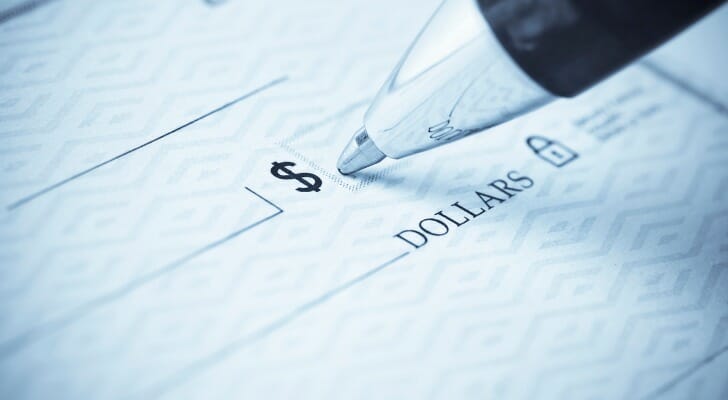A bank transit number, also known as a routing number, is a nine-digit number that helps US-based financial institutions identify the institution that has issued a check and other financial documents. Transit numbers have been around for more than 100 years, and they help facilitate and keep track of transactions between customers at different banks. Most people encounter transit numbers when setting up direct deposit payments or when transferring money between banks for checking or savings accounts.
Do you have questions about how your bank account can contribute to your long-term financial plan? Speak with a financial advisor today.
What Is a Bank Transit Number?
A bank transit number is also known as a routing number, or ABA RTN (American Banking Association routing transit number). It is a nine-digit code that identifies a financial institution and is used when transferring money or identifying specific bank accounts. The transit number is printed on checks so other banks can determine which bank the check was first drawn from.
Every financial institution (including commercial banks, investment banks, credit unions, and brokerage firms) has a specific unique number. That number is on all negotiable instruments issued by the institution. This includes any document that guarantees the payment of an amount of money. Examples include a check, a promissory note, or a bill of exchange.
The transit number is specific to the bank, not to you. If you and a friend both open checking accounts at the same bank branch, the routing number on both of your checks will likely be the same. The other number printed to the right of the transit number is your account number.
How Do I Find My Bank Transit Number?
If you have a checkbook, the easiest way to find your bank transit number is to simply look at the bottom left corner of any check. Your transit number should be printed there.
Other Ways to Find Bank Transit Number
If you don’t have any checks, the transit number can still be relatively easy to find. Here are four more ways to get this information:
- Visit your bank’s website.
- Check your bank’s mobile app.
- Telephone your bank branch or support line.
- Visit your branch in person.
Big banks like Wells Fargo typically have a different transit number for each state it has branches in. In addition to having multiple numbers for different states, some banks have different transit numbers for different types of transfers. Some banks assign one number for paper transfers, one for electronic fund transfers (EFTs), and one for wire transfers, because they handle these transactions in different ways. If you’re unsure about which routing number you need, just call your bank and they’ll be able to direct you.
Why Do We Need Bank Transit Numbers?
The primary function of bank transit numbers has changed over time. When the numbers first arrived in 1911, their purpose was to help banks send the checks they received back to the banks that first issued them. This helped banks to keep track of their transactions – a necessity in the days before computers automated such transaction tracking.
Since then, the function of transit numbers has expanded. Today transit numbers are used in the following ways:
- Wire transfers. Transit numbers identify domestic sending and receiving institutions to ensure money goes to the right partner to the transaction.
- ACH network transactions. Payments being transmitted between US-based financial institutions via the ACH system are tracked and delivered using the transit number. This includes bill payments and other electronic transfers.
- Direct deposits. The routing number helps to determine the bank the deposit is going to. From there, your individual account number helps specify things further.
Bank transit numbers are even more necessary today than they were in 1911. Today there are over 28,000 different financial institutions across the country. Many of them with remarkably similar names, transit numbers play a crucial role in keeping them distinct.
Note that when you are using a transfer app such as Zelle to pay a friend, you don’t need to know your bank’s transit or the transit number of the friend. All you need is the recipient’s phone number or email address. The app handles the transit number behind the scenes.
Bottom Line
Bank transit numbers are essential to our banking system. With thousands upon thousands of transactions taking place every day, banks need a way to quickly identify each other. Thanks to those nine numbers, we can enjoy conveniences like direct deposit and online transfers. The next time you need a routing or transit number, you’ll know where to look.
Tips for Banking Responsibly
- Saving money isn’t always easy, so talking with a financial advisor can give you peace of mind that you’re on the right track. Finding a financial advisor doesn’t have to be hard. SmartAsset’s free tool matches you with vetted financial advisors who serve your area, and you can have a free introductory call with your advisor matches to decide which one you feel is right for you. If you’re ready to find an advisor who can help you achieve your financial goals, get started now.
- If you’d rather manage your money without having to worry about business hours, you might like online banking. Without having to travel to a traditional branch, you can conduct your business online in your own time. Plus, you’ll still be able to access a network of ATMs if you need cash.
- When dealing with any bank, it’s crucial that you make sure you’re not paying any sneaky fees. Unnecessary fees can cut into your savings and erase the benefits of using a bank in the first place. One way to avoid this is to look for a free checking account at your preferred bank. You can easily access your money without having to worry about losing any of it.
Photo credit: ©iStock.com/zoranm, ©iStock.com/Anchiy, ©iStock.com/fluxfoto


